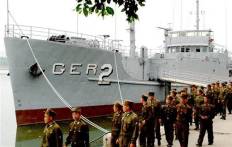The Doolittle Raid – 70 Years Later: Naval Officers and Planning
Here and elsewhere much has been written of the Doolittle raid, from the bookstand to Hollywood and the curriculum of War Colleges the world over. Coming fast on the heels of the stunning blows barely four months prior a malevolent arc of destruction and defeat stretching from Pearl Harbor back across the Pacific to the Philippines and the rest of Asia, the raid was, no, is emblematic of the American fighting spirit and ability to improvise on the fly and conduct improbable operations on the field of battle. From John Paul Jones’ raid on the English port of Whitehaven to putting a man on the moon barely a decade after the first tentative attempts to launch a satellite, our history has been replete with no small number of audacious operations. Of all these though, the Doolittle Raid is probably the best known and yet, there are aspects that still remain shadowed. To be successful required meticulous, but rapid planning. In short order an idea, germinated in Washington had to be planned, practiced, logistically provided for and executed in an air of ironclad secrecy.
This in an age where “netcentric” and “JOPES” weren’t even a mirage on the horizon.
As always, it was having the right people in place to do the heavy lifting behind the scenes that laid the groundwork for success. In the case of the Doolittle raid, there were four naval officers, one you have heard of, but two or three others you just as likely haven’t, who played key roles in the planning of the raid.
CAPT Francis S. Lowe: A member of the USNA class of 1915, a 1926 Naval War College graduate, a submariner, then-CAPT Low was assigned as Operations Officer on ADM King’s staff at CINCLANTFLT, and later followed him to Washington when King became CINC, US Fleet and CNO. Among his duties as Operations Officer was overseeing the ASW operations of the fleet, and it was in this capacity that he flew to Norfolk, VA in January 1942 to review the status of the USS Hornet CV-8. Chambers Field (the original, now part of the heliport today) had the outline of an aircraft carrier painted on it for FCLP (Field Carrier Landing Practice) which is used to maintain some of the skills necessary to conduct flight operations off an aircraft carrier – to include launching with a minimum of deck space available. It was during this trip that he observed some B-25s making passes at that outline in a mock attack and realized that twin-engine aircraft would fit on the deck of a carrier and wondered if the B-25s would be able to take off from a carrier. Upon his return to Washington, he mentioned his idea to the Admiral who thought it had merit as did General “Hap” Arnold (USAAF).
CAPT Donald Duncan: A 1917 graduate of the USNA, and holder of a MS in Radio Engineering from Harvard as well as a Naval Postgraduate school grad, then CAPT Duncan, a naval aviator with extensive carrier experience, was King’s Air Operations Officer and the one to whom it fell to evaluate the possible use of the B-25 from a carrier. In 30 handwritten pages, he outlined all the necessary details and precepts for a successful strike in a feasibility study forwarded to King and Arnold recommending the use of B-25s and oversaw the proof of concept flight that showed the Mitchell bombers could indeed, launch from a carrier deck. Subsequently he also oversaw the necessary logistical and administrative details needed to get the bombers to and onboard the Hornet at Alameda Naval Station.
LT Henry L. Miller: A 1934 graduate from the Naval Academy and native of Fairbanks, Alaska, then-LT Miller was a designated Naval Aviator. A multi-engine pilot and graduate of the Bombardier course at Sandia base and the All Weather course at Corpus Christi, he was serving as a flight instructor and Personnel Officer at Ellyson Field, FLA when tasked to train Doolittle’s pilots on takeoff techniques from the limited deck of a carrier. Shifting operations to Pierce Field (one of the outlying fields at Eglin AB – literally out in the sticks) LT Miller not only trained the raiders on take off techniques, but was also principle in teaching the finer points of shipboard life in general and accompanied them as operations shifted to Sacramento, CA and all the way to launch from the Hornet, 700 nm from Tokyo.
LT Stephen Jurika: Born in Los Angeles while his parents were visiting there, then LT Jurika grew up in the Philippines where his dad owned a number of plantations. He graduated from the Naval Academy in 1933 and served as a naval attache at the American Embassy in Tokyo before World War II. As the USS Hornet Association’s website notes, the plot thickens from there:
Being fluent in the Japanese language, he was able to collect significant information about the Japanese military and industrial capabilities, even photographing many of their sensitive sites. From August 1941 until October 1941, he reported to the Director of Naval Intelligence, providing a great deal of information about the Japanese threat, including specific information about the new “Zero†high performance fighter. In October 1941, he was involved with the commissioning of USS Hornet (CV-8), initially serving as the Flight Deck and Intelligence Officer. In mid-January 1942, he consulted to Captain Donald Duncan who was then conducting a feasibility study about launching a bombing raid against Tokyo. Lt Jurika provided a great deal of information about the types and locations of high priority industrial and military targets. Two months later, when the Hornet was carrying the Doolittle Raiders to their launch point, Lt Jurika spent many hours briefing them on the locations of the high value targets and optimum flight routes.
He also had a personal contribution to make to the raid:
One bomb was decorated with Japanese medals, donated by Navy Lieutenant Stephen Jurika, who had received them during pre-war naval attaché service and now wished to pointedly return them to a hostile government. (NHHC)
Each officer would go on to serve with distinction in the war and afterwards. CAPT Low took command of the cruiser Wichita and saw action from Africa to the Pacific. Returning to the US he was Chief of Staff for Tenth Fleet, running ASW operations in the Atlantic theater of operations and finished the war as Cruiser Division SIXTEEN supporting the invasion at Okinawa and strikes against the Japanese homeland. After the war he was in charge of the surrender and neutralization of all Japanese Naval installations in Korea and reported in November as Commander Destroyers Pacific Fleet, serving until March 1947, when, upon his advancement to Vice Admiral, he was given command of the Service Force, US Pacific Fleet. In November 1949 he returned to the Navy Department to conduct a special survey of the Navy’s anti-submarine program, and in February 1950 was designated Deputy Chief of Naval Operations (Logistics). He continued duty in that capacity until May 1953, when he became Commander, Western Sea Frontier, and Commander Pacific Reserve Fleet. He served as such until relieved of all active duty pending his retirement, effective 1 July 1956. He was advanced to Admiral on the basis of combat awards. CAPT Duncan would become the first CO of the lead ship of the Essex class CV and see action in the Marcus Islands and Wake. From here he would serve as CARDIV commander, CINCPACFLT Chief of Staff, DCN(Air) and finally DCNO before retiring in 1957.
Following the Doolittle raid, LT Miller commanded an Air Group on board USS Princeton (CVL-23), and during the remainder of the war he had command of Air Group SIX stationed on board USS Hancock (CV-19). Following the war he served in the Navy Department until July 1948, first assigned to writing Air Operations Instructions, later serving as Executive Officer, Air Branch, Office of Naval Research. For two years he served as Public Information Officer on the Staff of Commander in Chief, Atlantic Fleet, and from June 1950 to August 1952 served successively as Executive Officer of Composite Squadron SEVEN, and of USS Leyte (CV-32). Graduating from the Industrial College of the Armed Forces in 1953 and, he reported for duty in the Strategic Plans Division at the Office of the Chief of Naval Operation. Subsequent assignments saw him in command of USS Hancock, commander of CARDIV 15, and later, off Vietnam, CARDIV 3/Task Force 77/7th Fleet Carrier Strike Force. On July 22, 1959 Miller was commissioned a Rear Admiral, and was appointed Chief of Staff and Aide to the Commander Naval Air Force, Pacific. Rear Admiral Henry Louis Miller commanded Carrier Division FIFTEEN, which is the Anti-Submarine Hunter-Killer Task Group from May 1961 to June 1962. Admiral Miller also served as Assistant Chief of Staff for Plans, Joint Staff, Commander in Chief, Pacific, during the time when the turmoil in South East Asia escalated. He then assumed command of Carrier Division THREE, a Heavy Attack Carrier Task Group, and at the same time he took command of Task Force, SEVENTY-SEVEN, and the Carrier Striking Force of the SEVENTH FLEET and in this capacity, took the first nuclear power Task Force into combat with the enemy in Vietnam.
LT Jurika followed the Doolittle raid with an assignment to COMAIRSOLS on Guadalcanal as Air Ops officer, a tour which included a special operation that earned him a Legion of Merit. Returning briefly Stateside as a torpedo instructor, he returned to sea as navigator on the USS Franklin (CV-13) and in this capacity, was awarded the Navy Cross for his actions on the bridge in the wake of the attack and devastating explosions and damage that almost sank Franklin. After the war and a variety of foreign service tours, retired and began a career as a professor at Stanford University and the Naval Postgraduate School.
Note: The oral histories of several of the principals involved with the Doolittle raid and battle of Midway – including that of Stephen Jurika, are available through the Naval Institute via the ‘print-on-demand’ program. I think the advent of the 70th anniversary of the Doolittle Raid and the upcoming Battle of Midway observances would be a great time for the Naval Institue Press, in line with the Strategic Plan released at last week’s Annual Membership meeting, to announce it was making e-book versions available of these histories. w/r, SJS








It’s almost ALWAYS about the quality of one’s personnel, isn’t it? Which doesn’t bode well for the current Navy maniacal fixation on “diversity” above all, does it?
^This
w/r, SJS